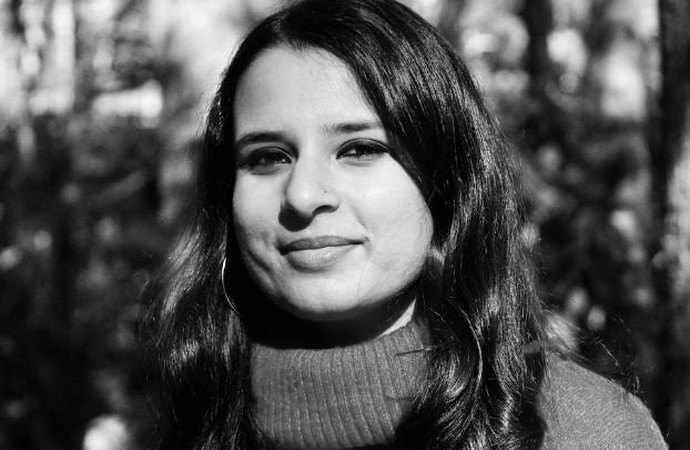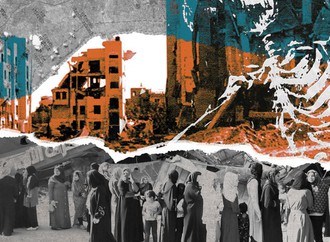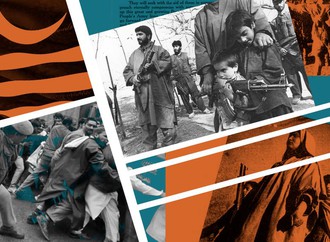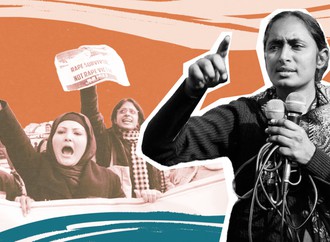This interview with Kashmir historian Hafsa Kanjwal delves into the complexities of India’s settler-colonial politics in Kashmir. Apart from detailing the evolution of the Kashmir Issue, this interview illuminates the similarities and differences between India’s and Russia’s long projects of occupation of Kashmir and Ukraine, respectively. This comparison reveals that even culturally, politically, and ideologically disparate entities, like Kashmir and Ukraine, may have remarkably similar histories of resisting imperial powers that have utilized both direct violence, including military invasions, torture, and mass killings, and structural oppression, such as censorship, propaganda, and manipulative politics to subjugate native populations. We believe that given this shared experience, it seems possible to communicate and foster a collective resistance.
This interview is presented in two parts. The first one focuses on the general history of the Kashmir Issue – the Kashmiri people’s struggle for self-determination against the Indian State. To this end, this first segment examines key historical moments in Kashmir’s modern history, various political responses to India’s forced rule over the region, and the impact of the struggle against India’s occupation on Kashmiri identity, culture, and life.
This second part of the interview analyses three distinct periods of upheaval and political change in Kashmir: Bakshi Ghulam Muhammad’s puppet regime from 1953-63; the armed insurgency of the 1990s; and Narendra Modi’s governance especially in the aftermath of the abrogation of Article 370 of the Indian Constitution. It will underscore the concrete organizational struggle for self-determination of the Kashmiri people against the Indian State, the role of censorship, Kashmiri cultural resistance, and broader geo-political connections, particularly regarding the Ukrainian and Palestinian questions.
Hafsa Kanjwal is an Assistant Professor of South Asian History at Lafayette College (Easton, Pennsylvania) and the author of Colonizing Kashmir: State-Building Under Indian Occupation (Stanford University Press, 2023). Her work offers readers a historiographical account and thorough analysis of India’s settler colonial and state-building practices during the 1950s-1960s in Kashmir. The interview is conducted by Salik Basharat Geelani, a Kashmiri doctoral student in the Dep. of English Literature at Vanderbilt University, USA; and Yuliia Kulish, a doctoral student in the Dep. of Literature, Kyiv-Mohyla Academy.
You’ve recently published a book titled Colonizing Kashmir: State-building under Indian Occupation, which follows the major political, legislative, and cultural events of 1953-1963 in Kashmir under Bakshi Ghulam Mohammad’s governance. Could you please tell us a bit about your book and its object of study?
When I was in the field doing my archival work, I was very curious about the decades in between partition, which happened in 1947 and where there's a lot of material written about Kashmir's history, and the 1980s/90s during which the armed rebellion, the militarization, and human rights violations took place and have been studied. I felt that there was a big gap in terms of the history of the 50s, 60s and 70s in Kashmir and I wanted to focus on that.
But why I focused particularly on Bakshi Ghulam Mohammad’s reign of power, which lasted from 1953 to 1963, is that in my oral interviews with people in Kashmir, I was very curious by how his reign in particular was depicted. On the one hand, he was depicted as someone who was a traitor because he had aligned with the Indian State and led a coup against Sheikh Abdullah, the first client politician, and so was seen as someone who had further entrenched India's occupation in Kashmir. During his time, the Kashmiri Legislative Assembly had affirmed the Constitution for the state, which confirmed the accession of Kashmir to India. On the other hand, a lot of people gave him credit for developing Kashmir and in particular, empowering Kashmiri Muslims by providing them with jobs and education and the prospect of upward social mobility. I was really interested in the paradox of this individual.
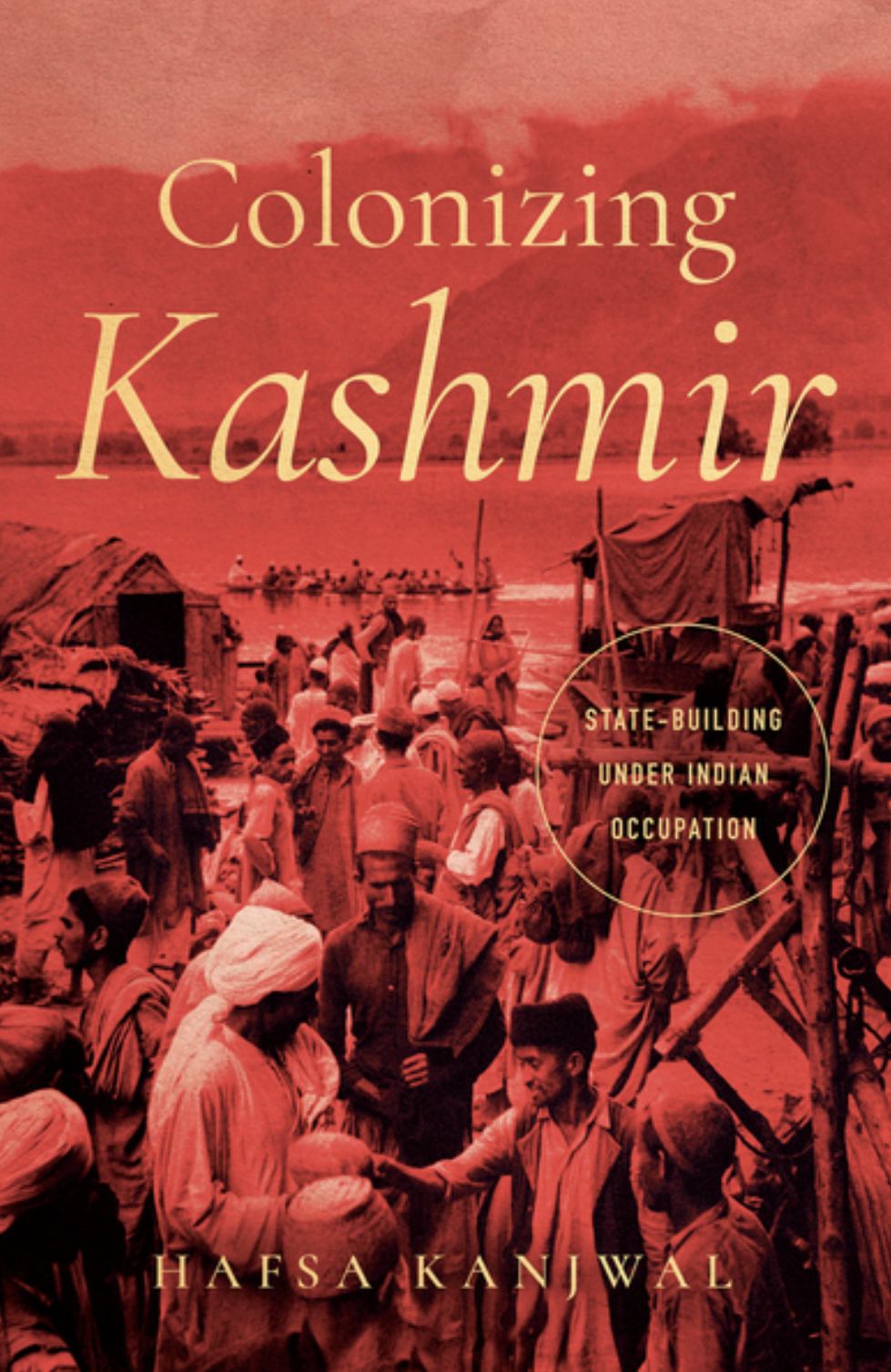
Hafsa Kanjwal's book Colonizing Kashmir: State-building under Indian Occupation
One of the things that I argue in the book is that India's colonial occupation took place in Kashmir through the installation of client regimes like Bakshi’s and through the particular forms of state-building and development that these regimes helped implement. Despotic States often manage political aspirations or develop certain modalities of control in colonial or settler colonial contexts through a kind of direct manifest violence that they engage in or necropolitical forms of violence that the States implement. While direct and necropolitical violence is foregrounded even in Kashmir, one of the things that I think this time period in Kashmir's history shows is that the rhetoric of “development” or what I call the politics of life[1] can also play a role in entrenching colonial occupation. And so, even though in this time period India's occupation looked very different from what would later happen with the militarization and armed rebellion, it was still meant to subjugate Kashmiri political aspirations.
In terms of how Bakshi’s reign and power transforms the Kashmir State and its relation to the Indian Republic, I focus on how his rule fully entrenches the legal, cultural, political, economic, financial, educational spheres of Kashmiri life into the Indian Union even as it does not succeed in emotionally integrating Kashmiris into India—a decade after Bakshi’s rule is over, there are mass mobilizations for self-determination in Kashmir again.
One of the main events of the period I study in the book, and the USSR plays an important role in this, is the high profile visit to Kashmir in 1956 by the Soviet premiers Khrushchev and Bulganin. Khrushchev and Bulganin officially visit Kashmir to see the ‘development’ that's happening in the state, and they're shown a good time and are taken to different state projects and tourist sites. At the end of their visit they announce that it seems to them that Kashmir has chosen to join with India! They also claim that it's for the good of the Kashmiri people that they’ve done this. So on the international stage, the Soviet Union plays an important role in vetoing any subsequent resolutions that would come up on Kashmir and in many ways contributes to the domestication of what was otherwise still considered an international dispute.
The armed insurgency of the 1990s is perhaps the most significant period (and symbol) of Kashmir’s resistance to the Indian State’s tyranny and oppression. Could you explain some of the mechanisms and apparatuses of Statist oppression (like torture insitutes, cordon and search operations, mass killings, army rapes, enforced disappearances, unmarked graves and disposal of bodies) that were employed in the 90s in Kashmir?
During this period, Kashmiris took up arms and significant mass mobilizations unfolded against India’s rule in the late '80s and '90s. The focus on how the Indian state manages this uprising shifts toward more necropolitical forms of governance. High-profile protests characterize the early '90s in Kashmir, spanning different towns, cities, and villages. In response, the Indian Army resorts to firing live ammunition into crowds, which results in a series of high-profile massacres. The idea was to make it very difficult for the general population to resist, to punish them both for resisting and supporting the armed uprising and making the cost of this resistance extremely high. During this era, stories abound of young men being apprehended or disappeared on suspicion of being militants. The army would cordon off entire areas, concentrating all forces in one zone, and go into people’s homes. They would sift through all belongings, even inspected containers of rice, spilling the contents to check for concealed guns or other hidden items, as I've heard from accounts of that time.
Furthermore, there was a practice of forcing people to congregate in local parks. Informers played a crucial role in pinpointing those perceived to be linked to militancy and similar activities. This is also a time when sexual violence and rape was used again, not just against Kashmiri women but also against Kashmiri men. Thousands of them were imprisoned and tortured. There were torture centers like Papa I and Papa II; homes of former bureaucrats, as well as schools, also served this purpose. Around 10,000 individuals disappeared, with many likely ending up in mass graves discovered in the early 2000s. There even emerged a category of something called “a half widow.” These were women that didn’t know whether their husband was dead or alive, their eligibility for remarriage, and essentially their marital status was unclear. This term basically represents the kind of limbo that many women had to deal with. Extrajudicial killings and the assassination of high-profile Kashmiri leaders and intellectuals were rampant. It was an incredibly violent time, strategically designed to tire the people out from wanting to resist and emphasize that the cost of resistance was just too high.
Apart from armed resistance, what other forms of opposition and refusal were employed by Kashmiris in the 1990s?
Kashmiris have consistently employed various forms of civil disobedience, including strikes known as "Hartaals". Particularly after incidents like killings or massacres, they would close businesses, shops, and schools, and halt transportation for days or even months. Despite facing economic and financial hardships, people sacrificed to sustain the momentum of the movement. There were curfews that were imposed by the government as well. I recall learning about protests where hundreds of thousands gathered in front of the United Nations office in Srinagar, submitting petitions and letters urging the UN to act and pay attention to the situation. While not much was accomplished, they attempted both local forms of resistance and appealed to the international community. Additionally, Kashmiri photographers and journalists played a crucial role in documenting the extent of the violence. They demonstrated remarkable journalistic skills, risking their lives. This documentation extended well beyond the 1990s. I think that's important because part of what the Indian state relies on is this narrative of normalization or that everything is fine, or things are normal. For people to actually bear witness to the kinds of things that Kashmiris were being subject to was a really important form of opposition and refusal.
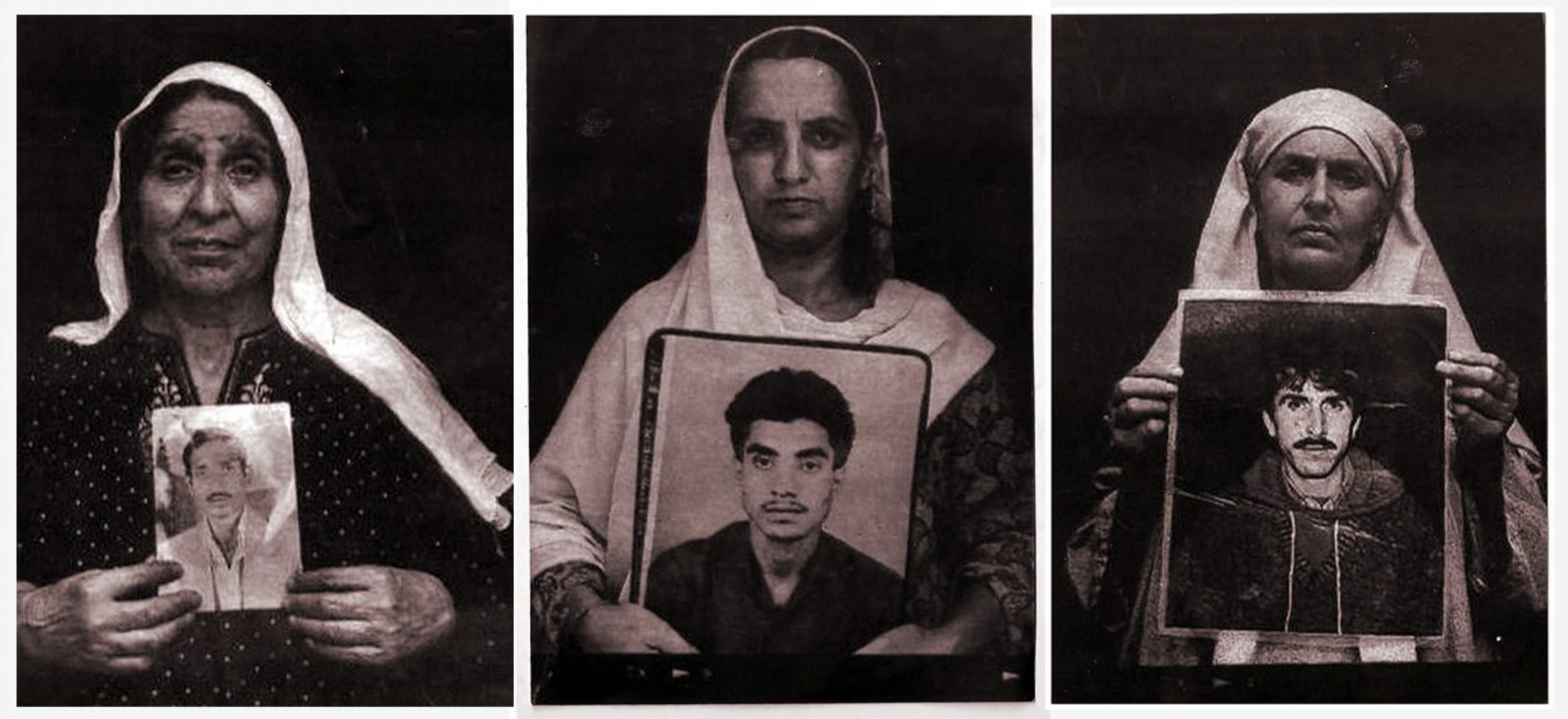
Photo: Association of Parents of Disappeared Persons
Today, censorship and violent crackdowns on dissent seem to be major themes in the Indian State’s approach to Kashmir. Further, Indian state violence is often masked by a rhetoric of progress aimed at portraying an illusion of normalcy to a general national and international public. What can you tell us about the functioning of India’s propaganda machinery and how it has developed over the decades to maintain these illusions of order in Kashmir? And, considering the ever shrinking space of dissent in Kashmir, how have dissenters adapted and responded to these challenges hoisted at free speech and expression?
I would argue that all forms of Indian society cohere on this one point, emphasizing the significance of their occupation of Kashmir. Whether it's politicians, civil society, academia, or the media, they all agree that Kashmir is an integral part of India, its people are happy with India, and it’s just Pakistan-sponsored terrorism that is causing issues. Kashmiris are fundamentally denied any political agency of their own. The rationale presented for India's military presence and actions in Kashmir hinges on the need to maintain a firm hand to protect Kashmir from Pakistan.
Regarding the propaganda machinery, there's so much of it. For example, the role of Indian cinema in shaping perceptions of Kashmir over the decades. Tourism, too, plays an important role in this narrative. Various spectacles of cultural events become instrumental. Take Republic Day, for example, with its attempt to cultivate consent on the ground. The Indian Army is involved in these events too, contributing to cultural and development projects with the aim of influencing the hearts and minds of the people.
I believe a recent incident earlier this year vividly illustrates how crazy things truly are on the ground in terms of the shrinking space of dissent. Any form of political speech or writing that directly documents the situation in Kashmir or critiques the Indian state has been criminalized. There's been immense self-censorship in Kashmir, especially since 2019. Earlier this year, a G20 meeting took place in Kashmir, marking the first international event with representatives from around the world after the abrogation. India hosted it in Kashmir to showcase control and normalcy to the international community. In response, young people in Kashmir used social media, employing humor and memes to challenge this narrative of normalcy. For example, the state claimed Srinagar was a smart city with ongoing development, and in response, these young individuals posted pictures of various global landmarks, like Big Ben in London, juxtaposed with a caption suggesting India's development of Kashmir's own Clock Tower. This served as a subtle critique of the normalization and development narrative. And yet even this form of expression was not allowed. Within hours of posting, many of these images were taken down, revealing the state's extensive surveillance capabilities in identifying and tracking the content creators. So people felt threatened and took it down. At present, it seems impossible to identify spaces where Kashmiris can exercise even subtle forms of critique, as the available space for such expression has clamped down.
Yuliia: Except for fleeing Kashmir and doing something from the outside.
Exactly. That also poses challenges because, in many ways, it means that you are probably not going to be either allowed back in. Many people also can’t leave because they are on travel bans or their passports have been suspended. If people end up leaving, their families get threatened back in Kashmir. Everyone must think twice about the implications for their families.
Civil societies have played an important role in highlighting and bringing to light the excesses of the Indian State. Could you explain the history of the Association of Parents of Disappeared Persons as well as the Jammu and Kashmir Coalition of Civil Societies, both of whom are under constant surveillance and threat today?
These two organizations have been instrumental in documenting various human rights abuses over the past few decades. Parveena Ahanger, the founder of APDP herself, experienced the disappearance of her son in the 90s. She did everything, appealed to different legal entities to at least uncover what had happened to him. She connected with other people whose relatives had also disappeared. Together, they formed a network of families affected by disappearances and have undertaken crucial documentation. Before 2019, they regularly organized monthly protests, gathering in a park with photographs of their family members, engaging in a demonstration to demand accountability from the state. The Jammu Kashmir Coalition of Civil Society, led by Khurram Pervez and Parvez Imroz, played a pivotal role too. Khurram is currently under arrest on charges related to terrorism or abetting terrorism. The JKCCS’ work, crucial in documenting various violations such as torture, the Armed Forces Special Powers Act (AFSPA), the impunity of Indian soldiers, and environmental degradation caused by the Indian state. Unfortunately, since 2019, they have become a major target of state repression. Much of this work has come to a standstill, as both the groups and the individuals associated with them have been systematically targeted. And that's quite frightening because whatever steps India takes in Kashmir, it’s not being documented, and there's no way to even conduct that kind of work. What unfolds in the next 5-10 years? Many of us are concerned about how we'll be able to track those developments.
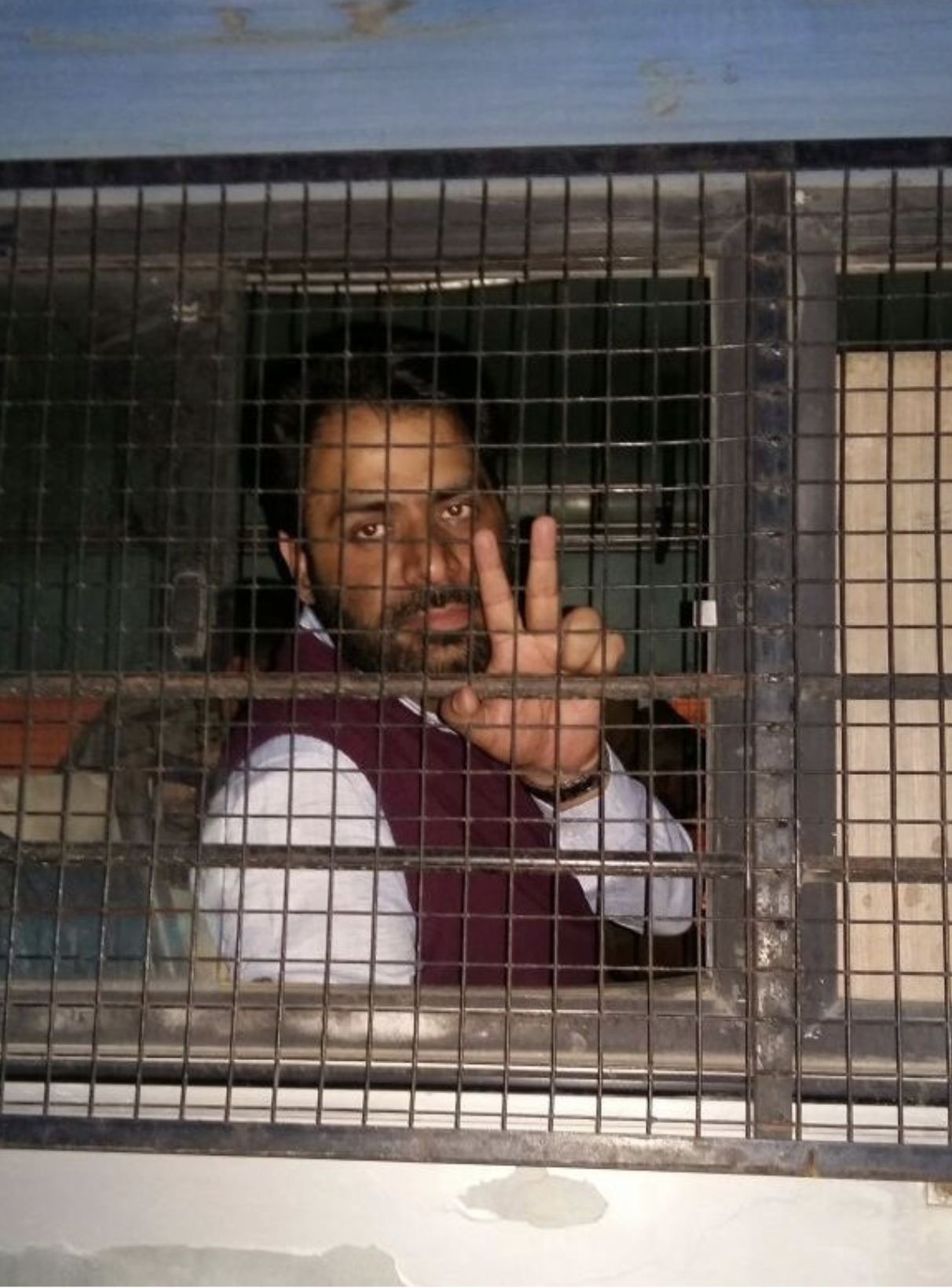
Khurram Pervez is taken to prison. Photo: Sameena Mir
From the abrogation of Article 370 of the Indian Constitution in 2019 to the Supreme Court hearings on the matter, a lot seems to have legislatively changed in Kashmir over the past few years. Considering the nature of the legislative system in India and the precedents of rulings against the desires of the Kashmiri public, what realistically can a Kashmiri expect from the Indian Legal System?
Unfortunately, the Indian legal system has played a role in entrenching this, from the Constitution itself to the Supreme Court and the lower courts. An important example I can share with you is from 2013, involving the execution of Afzal Guru by the Indian Supreme Court. He was falsely accused of participating in the 2001 Parliament attack in Delhi. Despite a lack of evidence, the state insisted on his execution, citing the need to alleviate the collective conscience of the Indian public to redeem the attack. This illustrates how the Indian legal system treats Kashmiris. Additionally, laws like the Public Safety Act, Unlawful Activities Prevention Act, and the Armed Forces Special Powers Act (PSA, UAPA, and AFSPA) allow the state to detain people for years without charge, and further enable the excesses of the Indian state rather than restraining them.

Chief Justice of India DY Chandrachud while giving the verdict on a batch of petitions challenging the removal of Article 370 of the Constitution, in New Delhi. Photo: PTI
Cultural and artistic expressions play a vital role in preserving a political entity. How would you describe the role of Kashmiri cultural and artistic resistance in the broad context of the struggle?
I believe it has consistently played a role, even if sometimes understated or not explicitly emphasized. Even in 1947, Kashmiri poets like Mehjoor and Abdul Ahad Azad were addressing the conditions and political challenges faced by Kashmiris. In my examination of the 1950s and 60s, I argued in one of my chapters that many artists and cultural producers had been co-opted by the state. However, in their non-affiliated writings, critiques of the state's normalization narratives were evident. Cultural and artistic expressions, particularly those directed towards an international audience in English, gained prominence after the 2010 summer protests. Various forms such as hip hop, memoirs, short stories, novels, art, photography, and film played a crucial role. Young Kashmiris tried to articulate their narrative to the world. Much of this expression has been curtailed and criminalized today. Looking ahead, we'll need to observe how cultural production evolves in this current moment.
Can you paint a portrait of a typical contemporary supporter of Kashmir's freedom movement? What are the common characteristics of individuals who advocate for this cause? Has there been a shift in a Kashmiri’s notion of and response to forms of resistance?
It is hard to paint a portrait as not much information comes out. But the ways in which Kashmiris express their resistance, given the limited scope of traditional resistance activities, include elements integrated into their everyday lives. This might manifest through subtle actions or exchanges, like a shared look while passing an army bunker. One of my colleagues, Mohamad Junaid, explores how even the way Kashmiris walk around the city is influenced by their resistance to the military's gaze. This embodied resistance is deeply ingrained in most people, although, unfortunately, there are individuals belonging to the collaborator or comprador class who have benefited from the occupation. Consequently, they don't see themselves as part of the movement, as their societal status is intricately linked to India's presence. However, there is a prevailing sense of embodied resistance, but expressing this resistance has become more challenging due to heightened fear. The increased number of informers, local spies, has made people wary of discussing their views. People are so nervous to even talk to their own friends about what they or even family members do, because they don't know whether they can trust them.
This project, titled "Dialogues of the Peripheries," focuses on regions like Kashmir that have chronically been politically, economically, and culturally marginalized and oppressed. We can draw parallels between Kashmir and other regions such as Palestine, Iran, the Kurds, some Russian territories that have their own vision of political future, certain Latin American states, and Ukraine, among others. However, Kashmir's narrative appears to be less prominent on the global stage. Why do you think Kashmir's story is often overlooked, while the narratives of Palestine and Ukraine receive more attention internationally?
In the book, I examine the internationalization of the Kashmir issue in the 1950s and 60s, which later became more domesticated, perceived merely as a dispute between India and Pakistan—an interstate dispute. There was no recognition that it was also an anticolonial movement or a people's struggle for freedom. This lack of understanding stemmed from its association with the interstate dispute, where the focus was on the territories and the two countries, rather than on what the people wanted. Also, the idea of India as a colonial power was challenging for many to grasp, given its significant role in global anti-colonial movements. India had a valorized history of resistance against the British, positioning itself as the leader of the nonaligned world and the Third World. The fact that a country championing other liberation struggles was now involved in its occupation was difficult for people to comprehend. The overlooking of this story is not only by the West, driven by its interests in the region and business deals with India but also due to the broader Cold War dynamics with China. India, seen as a rival to China, becomes a perceived safer ally. Additionally, Muslim-majority countries, except for Pakistan, historically have not said much about the issue, because they enjoy these close ties with India.
What role does Indian propaganda play in shaping the Kashmiri narrative globally, and how does this impact the perceptions and experiences of the Kashmiri people living/working in India?
India holds significant soft power due to the way it's perceived in the West and historically understood as a culturally rich and enigmatic place. The allure stems from Indian spirituality, attracting many in the West, figures like Gandhi, positive associations with Bollywood, cinema, and yoga. This positive image makes it challenging for people to see India as engaging in colonial domination. Moreover, the substantial Indian diaspora in business, tech, academia, and media plays a role in shaping the narrative on the world stage, contributing to the propagation of certain ideas. In terms of how this impacts perceptions, I haven't lived or worked in India as a Kashmiri, but I can share the experiences of my friends. We've discussed how certain leftist segments see them as victims but in general there is immense discrimination. However, there are also instances of discrimination, Kashmiri Muslim identity is viewed as a threat, reinforcing the broader logic of the War on Terror.

Prime Minister of Jammu and Kashmir Bakshi Ghulam Mohammad feeding Khrushchev, gushtaba, a Kashmiri meat delicacy. "Gushtaba diplomacy" was later used to depict the ways in which Kashmir's client regimes would utilize aspects of Kashmir's culture to meet their objectives or normalize India's occupation. Photo: from open sources
Salik: Yes, and I’d like to add that the sexualization of Kashmiris, particularly Kashmiri women (being compared to apples and fairies) is a persistent trope in India’s cultural imagination. This symbolic interplay, between typecasting Kashmiris as violent threats to the nation and then simultaneously as erotically charged bodies to be possessed, clarifies and confuses the idea of a Kashmiri, manipulating the overall perception of Kashmir for the local Indian population as well as for an international audience. In other words, Kashmiris as they are wanted by the Indian Other actively erase Kashmiris themselves.
The unequal distribution of global attention to wars and long-standing conflicts has given rise to a particular trend. Instead of developing strategies for collective action against global imperial power, there is a tendency to halt discussions when highlighting individuals or groups who might be seen as more privileged among the oppressed. For example, we may observe this phenomenon on social media platforms where there is a growing resentment towards certain groups, such as Ukrainians, receiving more international support from the West in comparison to others, like Syrians. Similarly, one can speculate that a similar situation applies to Kashmiris, who receive even less global attention. While recognizing these disparities is a crucial aspect of social critique, it's important to acknowledge that they can also be manipulated to create divisions.
What arguments do you think could help foster unity among these communities? On what shared principles should solidarity be built?
I try to be positive, but I find it challenging to envision unity or shared principles in the current world order. It's not only about the attention given to specific causes; rather, it's rooted in the unequal support some communities receive from the West, creating divisions. Besieged communities often must accept support from any available source, but when these supporting countries contribute to oppression elsewhere, building solidarity becomes exceedingly difficult. An illustrative example is the current situation with Ukraine and Palestine. The President's expressed support for Israel has given the broader Palestine solidarity movement pause in extending support to Ukraine. Part of the challenge is that the kinds of state centric dependencies that occupied communities around the world rely on are those very dependencies that enable these tensions. Perhaps, we should contemplate cultivating an ethic of solidarity that dismantles state-centric dependencies and focuses on the shared history of colonization or the inability to exercise sovereignty. However, this shift cannot occur until we fundamentally challenge both the contemporary liberal international order and the nation-state form itself.
The Russian invasion of Ukraine provoked a discussion about non-Western imperialisms. How do you see the role of Russia, China and India in the modern world from a Kashmiri perspective?
I believe some individuals still shape their political views based on the politics of nation-states, seeing it as their way out of their current situations. An example is how, due to China's rivalry with India, some Kashmiris may desire a greater role for China on the international stage, thinking it could counterbalance India's power, despite China's Islamophobia and its own colony in East Turkistan, with the Uyghurs. Unfortunately, these state-centric dependencies are what colonized communities are sometimes tied to. When facing Greater Western imperialisms, even within leftist movements, there's a tendency to romanticize countries like Russia, China, and India, imagining their potential role in creating a more multipolar world. But I think it's crucial to push back against this, as I fundamentally believe that nation-states won't save us. Besieged communities worldwide often end up in body bags in cold wars. So, it's essential to envision new possibilities and solidarities beyond these different imperialisms.
Hamas’ October 7th attack on Israel and the genocide in Gaza that the Israeli State responded with has led to the death of around 28,000 Palestinians (~70% of which are women and children) and around 1500 Israelis, and the displacement of 1.4 Million Palestinians. Several states, such as Bolivia, Chile, Columbia, Turkey, Bahrain, Jordan, and others have either severed diplomatic ties or pulled back their representatives from Israel, and hundreds of thousands of people worldwide have registered protests against Israel’s war crimes, indicating the gravitas of the excesses executed on Palestinian lives. However, despite growing international pressure, the Israeli State seems to follow through with its blatant disregard of international humanitarian laws. How do you understand and envision the role of a global legal and political system in this historical moment when Nation-States like Israel or Russia or India seem to be implementing, with a growing sense of impunity, intentional demographic changes, settler-colonialism, and genocide?
I believe this recent example of Israel's actions in Gaza, what Russia did in Ukraine, or India’s actions in Kashmir in 2019, underscores the failure of the current global legal and political system. It's evident that this order was established solely to safeguard the interests of powerful governments, and these laws and norms are selectively enforced on countries that challenge this order. What concerns me is the growing issue of impunity, where a country can blatantly violate existing international laws and be given a blank check to do so. I fear how this impunity might further embolden a country like India, which had already become more assertive after fully annexing Kashmir in 2019 with little international outcry and is currently engaged in immense persecution of Muslims. I'm concerned about the potential bold steps India might take next. However, it's also crucial to recognize the role global people and solidarity movements can play in holding their own countries accountable and building connections across different contexts. Seeing some of these connections gives me hope, but the level of impunity exercised by these governments is frightening. I fear that Gaza may become a test case for many other parts of the world.
What do you envision the future of Kashmiri resistance to be?
It's hard to say, considering international factors and the unfolding of India's settler-colonial project in Kashmir. The extent to which people can move beyond self-censorship and recognize the implications will shape the situation. Historically, resistance movements and mobilizations ebb and flow, taking different forms. The current high level of repression and attempts to garner consent for India's latest settler-colonial move create uncertainty, and we must wait and see. I want to remain hopeful for greater awareness and solidarity on Kashmir. As we see today with Gaza, people around the world need to mobilize to disrupt these colonial entities and work to end their own state’s complicities.
Footnotes
- ^ A term borrowed from Neve Gordon.

